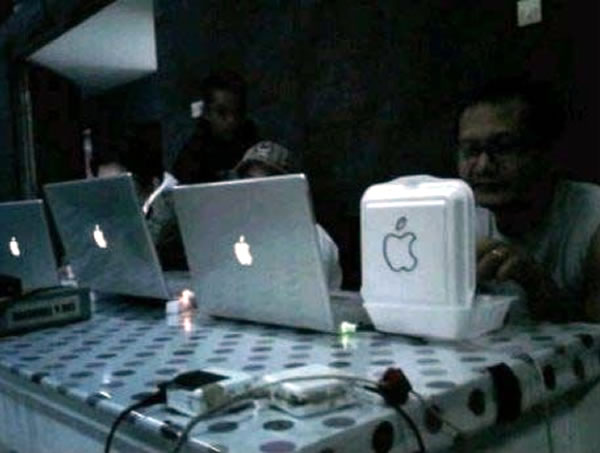
This article also appears in The Adventures of Accordion Guy in the 21st Century.

In a piece titled Reddit Co-Founder Charged with Data Theft, the New York Times reports that my friend Aaron Swartz, whom I met back during “Bubble 1.0”, has been indicted on charges that he stole over 4 million documents from MIT and the academic paper archive JSTOR.
The full text of the indictment states that his violations are:
Point of information: Aaron isn’t a cofounder of Reddit, but he did play a role in its earliest days. Reddit acquired his company, Infogami, about six months after Reddit’s launch.
While I’m not up to speed on what Aaron did or the events leading to the indictment, I advise everyone to hold back before making snap assumptions of Aaron’s guilt. We’ve all seen the ridiculous lengths that ambitious prosecutors will go to and distortions they will circulate when charging someone with violations that have some sort of technical component. For those of us from Toronto and especially the Hacklab, the case of Byron Sonne and absurdly exaggerated charges related to his G20 activity is still a fresh memory.
I do get the feeling that once I’ve gotten more info about the case, it’s going to be one of those times I say “Well, I see the good intentions, but have issues with the execution. Serious issues.” Once again, I’m getting Byron Sonne deja vu.
The server for Demand Progress’ website is getting swamped right now, so I’ve posted their statement about Aaron’s indictment below:
Cambridge, MA – Moments ago, Aaron Swartz, former executive director and founder of Demand Progress, was indicted by the US government. As best as we can tell, he is being charged with allegedly downloading too many scholarly journal articles from the Web. The government contends that downloading said articles is actually felony computer hacking and should be punished with time in prison.
“This makes no sense,” said Demand Progress Executive Director David Segal; “it’s like trying to put someone in jail for allegedly checking too many books out of the library.”
“It’s even more strange because the alleged victim has settled any claims against Aaron, explained they’ve suffered no loss or damage, and asked the government not to prosecute,” Segal added.
James Jacobs, the Government Documents Librarian at Stanford University, also denounced the arrest: “Aaron’s prosecution undermines academic inquiry and democratic principles,” Jacobs said. “It’s incredible that the government would try to lock someone up for allegedly looking up articles at a library.”
Demand Progress is collecting statements of support for Aaron on its website.
“Aaron’s career has focused on serving the public interest by promoting ethics, open government, and democratic politics,” Segal said. “We hope to soon see him cleared of these bizarre charges.”
Demand Progress is a 500,000-member online activism group that advocates for civil liberties, civil rights, and other progressive causes.
Aaron Swartz is a former executive director and founder of Demand Progress, a nonprofit political action group with more than 500,000 members.
He is the author of numerous articles on a variety of topics, especially the corrupting influence of big money on institutions including nonprofits, the media, politics, and public opinion. In conjunction with Shireen Barday, he downloaded and analyzed 441,170 law review articles to determine the source of their funding; the results were published in the Stanford Law Review. From 2010-11, he researched these topics as a Fellow at the Harvard Ethics Center Lab on Institutional Corruption.
He has also assisted many other researchers in collecting and analyzing large data sets with theinfo.org. His landmark analysis of Wikipedia, Who Writes Wikipedia?, has been widely cited. He helped develop standards and tutorials for Linked Open Data while serving on the W3C’s RDF Core Working Group and helped popularize them as Metadata Advisor to the nonprofit Creative Commons and coauthor of the RSS 1.0 specification.
In 2008, he created the nonprofit site watchdog.net, making it easier for people to find and access government data. He also served on the board of Change Congress (now Fix Congress First!), a good government nonprofit.
In 2007, he led the development of the nonprofit Open Library, an ambitious project to collect information about every book ever published. He also cofounded the online news site Reddit, where he released as free software the web framework he developed, web.py.
Press inquiries can be directed to demandprogressinfo@gmail.com or 571- 336- 2637
The second article in my series on BarCamp New Orleans is up on the Shopify Technology Blog. This one’s topic: The Schedule Grid, the heart of every BarCamp.
I’m at BarCamp NOLA (a.k.a. BarCamp New Orleans) right now, and I’ve posted the first of a series of blog entries about the event over at the Shopify Technology Blog. Check it out!
Creative Commons photo by Håkan Dahlström
This Saturday in San Francisco, Posterous (a very nice, simple web publishing platform) are hosting a Hack Day at their headquarters. They’ve just put out a new API and they’re inviting developers to take it out for a spin and meet their development team up close and personal, and in return, those developers will get food, Red Bull and beer, they’ll get taken out for drinks afterwards, and they’ll even get prizes!
Here’s the type of person they’re hoping will attend, in their own words:
Any developer interested in using the Posterous API to build something cool. So far, we know of mobile apps and a few web services built on top of Posterous. Whether you need ideas on what to build, are looking to team up with someone else or are already working on an app, the Posterous dev team will be here to help.
We Shopifolks believe in Hack Days, and while we can’t be there in person — we’ll explain in a moment — we will be there in spirit: we’re giving away an iPad as a prize! Write an application that makes use of the Shopify API as well as the Posterous API and you’ve got a good chance of winning it.
Here’s some quick info about Posterous’ Hack Day:
Creative Commons photo by Matt J. Carbone.
This Sunday in New Orleans, as part of BarCamp NOLA, there will be a Hack Day, and both Edward Ocampo-Gooding and I will be there!
Saturday is the regular BarCamp with the usual unconference-y stuff. Things change gears on Sunday, when people are invited to participate in a “giving back” exercise and collaborate in an exercise where “Developers, designers, educators, content writers, and videographers collaborate to build and launch a project in a single day.”
Here’s the quick info:

Don’t forget: Shopify’s second pub night is tonight! Come hang out with the Shopifolks, whether your interests are in tech, creative, “bidniss” or just good conversation, food and drink. We’ll be at Peter Devine’s (in ByWard Market — 73 Clarence Street, at William) from 5:30 until about 9:30 or so. Join us!
This article also appears in the Shopify Technology Blog.
The folks at Heroku have put out a press release (okay, PR people, I’ll call it a news release. Happy now?) as well as a blog post announcing that Yukihiro “Matz” Matsumoto has joined them. A quick recap for those of you unfamiliar with those names:
Here’s the picture from the blog entry with the announcement. I hope it becomes Matz’s business card!

What does this all mean in the end? Think of it as an artist/patron kind of relationship. Open source software has had a number of notable relationships of this sort:
In all these cases, it was an organization with a fair bit of money hiring a developer who built the OS or language they use. The organization benefits from continued development of that open source OS or language, and the programmer benefits from a steady paycheck. Luckily, we also benefit!
According to the Heroku blog, Matz and “a small team of Ruby’s core committers” will continue to work on the Ruby programming language. They close their entry with this:
We love Ruby, and we are honored to be able to give back to the community and to Matz, the Ruby dai-sensei, by providing resources for him and his team to continue to design and architect the language.
Sounds good to me. Time for a celebratory dance: